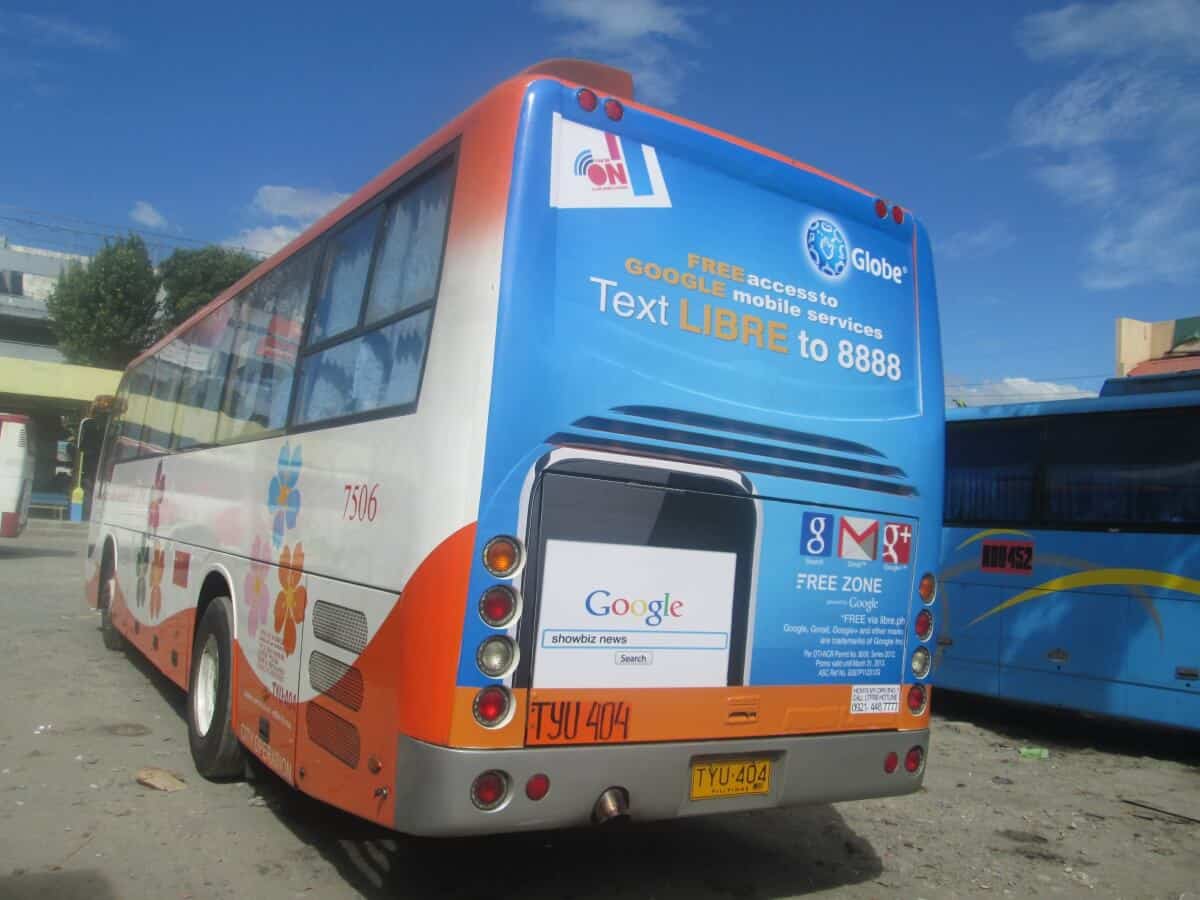Transit Advertising Philippines for Unmatched Brand Name Visibility
Transit Advertising Philippines for Unmatched Brand Name Visibility
Blog Article
Understanding the Function of Transportation Advertising in Enhancing Brand Name Visibility and Consumer Involvement
Transit marketing has actually emerged as an essential component in the marketing landscape, using unique chances for brand names to elevate their exposure and involve consumers successfully. With the ability to reach a captive and varied audience throughout their everyday commutes, these advertising and marketing strategies are not merely about visibility; they are about creating meaningful connections with prospective consumers. As we explore the diverse advantages and innovative methods within transportation advertising and marketing, it becomes important to take into consideration how these aspects collectively influence consumer understanding and behavior, raising concerns regarding their long-term influence on brand name loyalty.
Meaning of Transit Advertising And Marketing
Transportation advertising and marketing describes the technique of advertising items, services, or brands with ads placed around public transport systems. This type of advertising incorporates a selection of placements, including posters on trains and buses, electronic screens at transportation terminals, and wraps on the outside of lorries. It intends to reach a varied target market, maximizing the high foot web traffic related to public transportation.
Transit marketing is strategically positioned to record the focus of commuters, that usually invest significant time traveling or waiting. By incorporating promotions right into the everyday regimens of individuals, brand names can create a long-term perception and foster brand name recognition. The tool is especially reliable in urban settings, where public transportation is a key mode of traveling.
Additionally, transportation advertising can promote localized targeting, enabling businesses to get to specific demographics based on transportation routes and terminal locations. As city populations expand and using public transport rises, this advertising technique has obtained importance as an essential element of incorporated marketing methods. The dynamic nature of transit marketing, combined with its capability to engage consumers in a restricted atmosphere, emphasizes its significance in modern advertising practices.
Advantages of Transit Advertising And Marketing
The performance of transit marketing lies in its capacity to deliver a multitude of benefits to brands seeking to improve visibility and involvement. Among the primary advantages is the extensive reach it provides; transit ads can successfully target varied demographics across metropolitan areas, reaching both commuters and pedestrians alike. This broad direct exposure considerably increases brand name recognition.
An additional benefit is the high frequency of perceptions. As transit automobiles travel along recognized routes and stop at multiple locations, they produce repeated exposure that strengthens brand messages. This frequency cultivates knowledge, which is critical in customer decision-making.
Transportation marketing is also cost-effective contrasted to various other media platforms. Given its large reach and capacity for high impressions, brand names usually experience a reduced cost per thousand impacts (CPM), optimizing their advertising budget.
In addition, transit ads can produce a sense of area connection. By aligning with neighborhood transit systems, brand names can resonate with local target markets and foster a feeling of regional pride. This local method enhances brand name loyalty and interaction, making transit advertising an engaging selection for companies aiming to strengthen their presence in the marketplace.

Reliable Techniques for Transportation Campaigns
To maximize the effect of transportation campaigns, brand names ought to utilize tactical preparation and execution tailored to their target market. First, determining the demographic attributes of the target market utilizing public transportation is important. This permits brands to produce personalized messaging that resonates with possible customers.
Following, picking the best transportation mediums is important. Whether using bus covers, subway posters, or digital screens, each tool has one-of-a-kind advantages that can enhance exposure. For example, dynamic visuals on bus wraps can bring in focus, while electronic ads can be updated often to show prompt promos.
In addition, integrating a cohesive branding method throughout transit platforms makes sure consistency and reinforces the brand's identification. Making use of captivating styles and memorable taglines will certainly enhance brand name recall amongst travelers.
Lastly, timing is a crucial factor in executing successful transportation projects. Introducing projects during top travel hours or local events can considerably enhance visibility and engagement. By employing these strategies, brand names can properly harness the possibility of transportation marketing, promoting greater awareness and connection with their target market. Inevitably, a well-executed transit campaign can drive substantial development in brand name exposure and consumer engagement.

Gauging Influence and Interaction
In evaluating the effectiveness of transportation ad campaign, exact measurement of influence and interaction is important for brand names seeking to maximize their advertising strategies. Metrics such as reach, regularity, and impressions supply foundational information to analyze presence. Examining these elements helps determine the number of prospective consumers are exposed to the promotions throughout their day-to-day commutes.
Involvement can be further gauged through customer communications, such as website traffic, social media discusses, and straight reactions to calls-to-action featured in the advertisements. Making use of devices like QR codes or one-of-a-kind Links can help with monitoring see post of customer behavior straight linked to transportation projects. Surveys and feedback systems also act as beneficial approaches to collect qualitative data on consumer assumptions and recall of the ad.
Moreover, advanced analytics and acknowledgment designs can associate transportation exposure with subsequent investing in actions, supplying understandings into the return on investment. By utilizing a detailed technique that combines qualitative and measurable actions, brand names can establish a nuanced understanding of their transit marketing effect. Inevitably, this data-driven strategy allows brands to fine-tune their campaigns, ensuring they resonate successfully with target market and enhance general brand visibility.
Situation Researches of Successful Campaigns
Effective transit advertising campaigns work as engaging instances of how reliable techniques can raise brand name visibility and interaction. Transit Advertising Philippines. One significant case is the "I Love New york city" campaign, which changed the city's image and attracted millions of visitors. By utilizing metro ads, signboards, and bus covers, the campaign created a strong, natural brand identity, causing a significant uptick in tourist and neighborhood organization patronage
One more exemplary project is Coca-Cola's "Share a Coke" initiative, which leveraged transit advertising to individualize the brand name experience. By featuring popular go to this website names on marketing products throughout numerous transit platforms, Coca-Cola fostered a much deeper psychological link with consumers, encouraging them to share their experiences on social networks.
Furthermore, the "Got Milk?" campaign properly used public transport ads to get to a wide audience, enhancing the message of the relevance of milk in a balanced diet regimen. The campaign saw a quantifiable rise in milk usage in target demographics.
These study illustrate that when performed attentively, transportation marketing can substantially improve brand name presence, foster consumer engagement, and drive quantifiable results, demonstrating its essential role in modern advertising methods. - Transit Advertising Philippines
Verdict
In final thought, transit marketing offers as an important device for enhancing brand visibility and fostering customer involvement. Inevitably, the capability to gauge involvement and evaluate effective case studies underscores the performance of transit advertising and marketing in driving brand commitment and customer communications.
Transportation marketing has arised as a pivotal aspect in the advertising landscape, using special chances for brand names to boost their visibility and involve consumers properly.Additionally, transit advertising and marketing can promote localized targeting, allowing businesses to reach details demographics based on transportation routes and station locations.In evaluating the performance of transportation advertising projects, accurate measurement of effect and interaction is vital for brand names looking for to optimize their advertising approaches.Successful transportation marketing projects serve as engaging instances of just important site how reliable methods can elevate brand name exposure and interaction.In conclusion, transit advertising and marketing offers as an important device for boosting brand visibility and promoting customer interaction.
Report this page